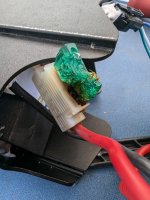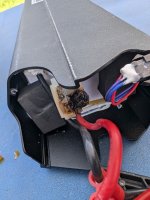hi all,
I have a blown fuse and melted [1] fuse holder on the battery of my Surface 604 Shred (2018). It's actually the second time this happened (the original fuse holder also melted as did the replacement fuse). Both times it happened with a fully charged battery when accelerating hard.
What is a good replacement fuse holder that can withstand high temperatures for this application? How to calculate the right amps for this fuse (I'm guessing it's something along the lines of 40A)? How can I try to avoid having the fuse holder melt on me (besides making sure all contacts are good)?
Thanks!
[1]



I have a blown fuse and melted [1] fuse holder on the battery of my Surface 604 Shred (2018). It's actually the second time this happened (the original fuse holder also melted as did the replacement fuse). Both times it happened with a fully charged battery when accelerating hard.
What is a good replacement fuse holder that can withstand high temperatures for this application? How to calculate the right amps for this fuse (I'm guessing it's something along the lines of 40A)? How can I try to avoid having the fuse holder melt on me (besides making sure all contacts are good)?
Thanks!
[1]










